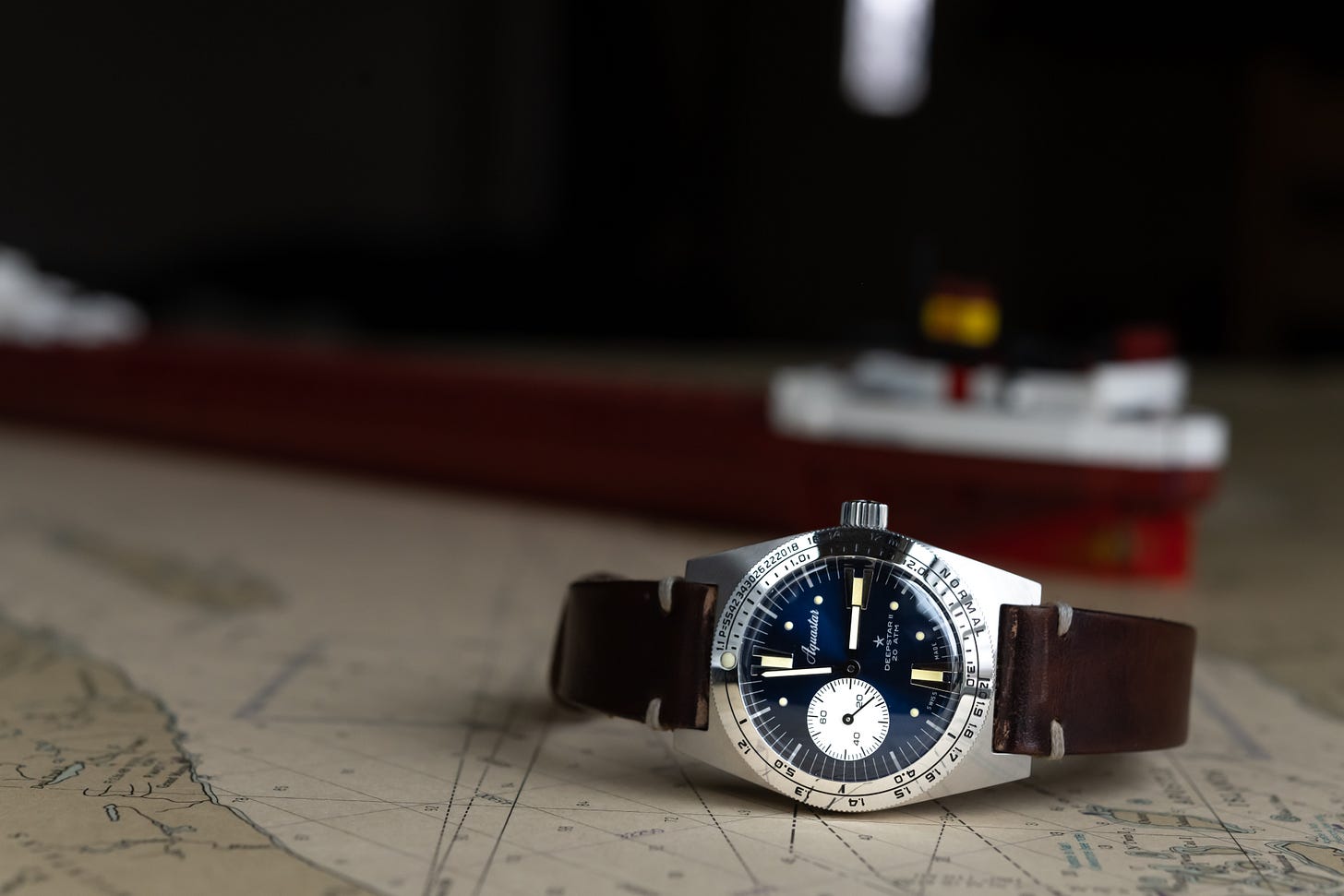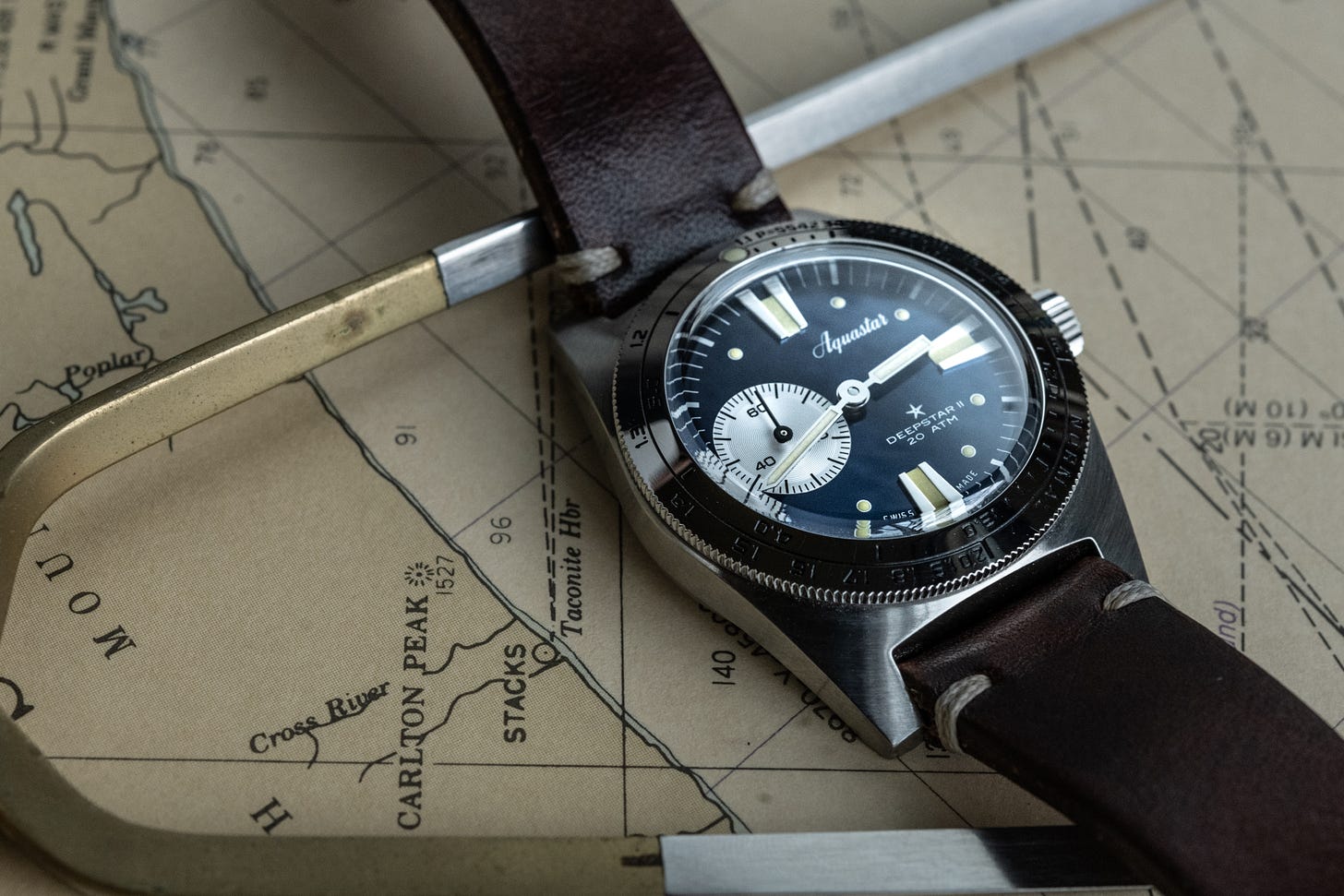Between the Devil and the Deep Blue (Inland) Sea
Musings on evolution inspired by the new Aquastar Deepstar II
Note: This is not a watch review. If you want specs and details about the new Deepstar II, visit Hodinkee or other fine watch publications. For more of my, and James Stacey’s, thoughts on the watch, check out Episode 170 of The Grey NATO.
Last Wednesday was the anniversary of the demise of the “world’s second most famous shipwreck,” the 729-foot freighter, Edmund Fitzgerald in Lake Superior. To commemorate the somber event every year, the historic Split Rock Lighthouse, on the north shore of the lake, holds a small bell ringing ceremony and then lights its beacon for just that one night. I’ve long wanted to go for this fairly niche event but the distance and the fact that it often occurs midweek during a notoriously wicked weather month has kept me away. But this year, Gishani and I piled into our drafty 30-year old Land Rover and aimed north for a four-hour drive. We found a last minute deal on a cabin rental the night before and settled in just as November’s early dusk dropped its curtain. On my wrist for the trip was the all new Aquastar Deepstar II, a very analog, mechanical dive watch that reimagines the history of a company that couldn’t survive the advent of more digital, battery powered technology. I couldn’t help but draw some parallels. Bear with me.
The history of nautical navigation is as fascinating as it is well documented. It’s also well known to students of horology , namely due to the vital role that a precise timepiece used to play in getting ships from A to B across the wild, wide oceans. Days and weeks away from any sight of a friendly coastline used to mean a ship could be blown, or unwittingly steer, off course and end up far from its planned destination or, worse, find itself run up on a rocky shoal somewhere, often with great loss of life and cargo. Watching the stars and heavenly bodies could only get you so far. It was the development of the chronometer that really opened up the world to reliable maritime exploration and trade.
But what about on the inland seas, the Great Lakes, that slash from the Atlantic in a connected watery chain into the wheat- and iron-rich heartland of the North American continent? Just 20 year after John Harrison’s H4 chronometer was sea trialed on a voyage from England to Jamaica, beginning the “longitude” age, the beginning of a new era in Great Lakes navigation began as well. As a direct response to the disastrous foundering of the schooner, HMS Ontario, the British constructed a lighthouse at the mouth of the Niagara River in Lake Ontario in 1781, thus making Great Lakes navigation safer.
Over the centuries, that first light station was followed by hundreds more peppered around the coasts of all five lakes, on both sides of the Canadian-U.S. border. Though the Great Lakes are all big enough that a ship can easily be out of sight of any coast, the use of a chronometer was less prevalent. Mariners typically relied on dead reckoning to navigate, using landmarks to guide them from one port to another. This largely visual means of wayfinding had its obvious drawbacks, at night or in storms when land became obscured. The lighthouses became vital aids, not only to warn ships of promontories and reefs, but also to let them know exactly where they were. Each light beacon had a distinctive “code” in the height of the beacon and the timing of its flashes. Thus, a navigator could move through the lakes, keeping track of these unique waypoints, until his ship reached safe port.
Of course, as with the rest of our modern world, this means of navigation is not used anymore. An evolution of World War II technology, LORAN-C, which used radio signals from strategically placed transmitter beacons, supplanted the visual medium of a lighthouse, and then, in 2009, even that method became obsolete as GPS became the gold standard for maritime navigation. The lighthouses now stand as reminders of a more analog, treacherous, and yes, adventurous era of seafaring. OK, you say, thanks for the history lesson, but what does all of this have to do with a dive watch?
I’m a selective user of technology, but far from a technophile. The MacBook on which I’m typing this is merely a soulless tool—vital to my work, amazing in its capabilities, but I feel no attachment to it. It is a GPS to the typewriter’s lighthouse, to stretch the analogy here. I can be fairly certain they’ll never fire up the LORAN transmitter beacons to commemorate any shipwrecks, but there also hasn’t been a shipwreck with loss of life on the Great Lakes since the Fitzgerald sank in 1975.
Divers used to get decompression sickness, more colloquially known as “the bends,” with disturbing regularity in the first few decades after SCUBA was invented. Old, bold divers could be recognized by those with pronounced limps or chronic joint pain. In the 1950s and ‘60s, donning a tank to go exploring underwater was, in some ways, to become a guinea pig in your own physiology experiments. Navies and explorers developed complicated tables to calculate the effects residual nitrogen had on the body during long, deep dives or repetitive diving. The best practice was to consult the table, set your watch’s timing bezel, and go diving, making sure not to overstay your prescribed bottom time. If you did, you had to pause on your way back to the surface to decompress, then gingerly climb back onto the boat and wait for telltale signs of the bends. Live to dive another day.
As time went on, the watch companies got in on the attempts to make diving safer and one brand that led the way was Aquastar. The company, which grew out of an offshoot of the ancient Jean Richard brand, was dedicated to building watches for watersports, specifically sailing and diving. One of its earliest successes was the Deepstar, a quirky chronograph whose elegance belied its complexity. On the rotating bezel of the watch were two scales—a simple elapsed time one, and another engraved with a series of hashes and numerals corresponding to a table that was included with the watch. This table was key to not only calculating no deco limits (the time you could spend at any given depth before you needed to decompress) but also the duration of surface intervals and the adjusted bottom times for subsequent dives. This system was developed with a Belgian diver and scientist named Marc Jasinski at the request of Aquastar’s hydrophilic founder, Frédéric Robert. The watch was adopted by as disparate a group of diving royalty as Jacques-Yves Cousteau himself, the shark researcher Eugenie Clark, and even freediver, Jacques Mayol, who would have had no need for the decompression calculator functions. The Deepstar was nothing short of a revolution at the time, ahead of its time, really.
Aquastar went on to enjoy a good decade of success, with its later Benthos also becoming a well regarded tool adopted by serious divers. But, as the well known story goes, the advent of quartz technology and the prevalence of affordable battery powered watches spelled doom for this niche producer of Swiss mechanicals. The company changed hands, focused on digital regatta timers and the name fell from prominence into relative obscurity other than among the dive watch collector cognoscenti. One of those was Rick Marei, whose passion for vintage dive watches is well known by now, and who had success at the helm of Doxa with vintage revivals. After he left Doxa, Marei turned his focus on the brand he’d long wanted to bring back to life: Aquastar. The first watch he expertly recreated was the Deepstar itself, about which I’ve written extensively. Now, today as a matter of fact, comes the public launch of its successor, the Deepstar II.
If there was one lament about the Deepstar reissue of 2019, it was its size. Rather than retaining the original’s 37 millimeter case dimension, it was enlarged to suit modern tastes, to 40mm. It was also thicker and longer across the wrist. It worked well for me, but I often wondered what the original felt like, as did many others. The Deepstar II answers that, albeit in different form. The new watch is the exact size of the original Deepstar chronograph of 1965. But it’s not a chronograph. It’s a time-only dive watch with a small seconds subdial at 9:00. On first glance, or seen from a distance on someone’s wrist, it looks just like the Deepstar, but then you notice it’s reversed, and, wait, no pushers. The dial is a mirror image of the chronograph, with the silvery spiraled subdial on the left instead of the right, and the swoopy, midcentury Aquastar wordmark on the right side now. Other than that, it’s a Deepstar through and through. In fact, with the polished engraved decompression calculator bezel, it retains the same functionality of the original Jasinski designed watch of the mid-60s. You really don’t miss the pushers or the central seconds sweep hand. On the one hand, this is a quaint, 37mm midcentury watch with its off-center small seconds, but then you’ve got this rather intimidating bezel with its arcane series of numbers, to remind you that, at one time, this was the height of technology. This was the dive computer of 1965, ne plus ultra.
As I’ve written before, I regularly use a dive computer. It’s a very sophisticated one at that—a Garmin Descent MK2. It leaves nothing for me to calculate, from no deco time, to deep stops, bottom time, right down to my underwater heart rate, air consumption, and GPS entry and exit points. Jasinski could have never dreamed of this watch in the early ‘60s. Every diver nowadays wears a dive computer of some sort. Watches are seldom seen underwater anymore. Has it made for more complacent divers? Have I become too reliant on my Garmin so that, if it quit on me mid-dive, I’d be lost at sea or surface in a rictus of bends-induced paralysis? I hope not.
We live in an ever more cocooned world. Our cars have blind spot warnings, backup cameras, and nary a manual transmission to be found. We navigate using our phones. Does anyone know how to build a fire anymore? Our connected dive computers can tell us when to surface from a dive and how long to stay on the surface before diving again, not to mention if we missed any text messages while underwater. I’m not here to lament the “good old days.” Those days were dangerous and difficult, no question. To go back to planning my dives around a paper spreadsheet would be silly at best, reckless at worst. But I think the continued presence of watches like the Deepstar and now the Deepstar II serve as an homage to a more analog era when diving required a bit more thought and consideration. Just like nautical navigation did. To wear the Deepstar II whether for diving or not, reminds me of how dangerous and cutting edge things used to be, just as attending a bell ringing for dead sailors reminds me of how treacherous plying the Great Lakes once was. What exists in our lives to make us appreciate the advantages that technology affords us while reminding us of what it is that’s being made easier, or makes us safer? Memorial ceremonies at lighthouses, old Land Rovers, mechanical dive watches, and not much else.
Rick Marei says that the impetus behind creating the Deepstar II was to imagine where Jasinski, Robert, and Aquastar would have taken the Deepstar had the brand continued to make dive watches. Remove the chronograph functionality to make a simpler, time-only watch perhaps, but keep the important dive computing functionality of the patented dual-scale bezel. And then beyond. In reality, the natural evolution of this form logically leads to the Garmin Descent I now wear diving. It is, improbably, the direct descendant of the Aquastar Deepstar, just as the lighthouses were built in response to shipwrecks, LORAN replaced lighthouses, and GPS replaced LORAN. The latest iteration of so much technology seems less romantic and evocative which is why we are drawn to the nostalgia of earlier eras.
Some of us more fully embrace technology, surrounding themselves with the latest and greatest—iPhones, smart TVs, Alexa, Tesla, and the like. Though I dip my toe in this realm, my life is a woven blend of the high and low tech. Consider even my trip north last week. We booked our rental cabin on an iPhone app, then drove north in a 30-year old diesel truck with a stick shift and no cruise control. The morning of the event, we bought into the public stock offering of a new electric truck brand, then attended a memorial event at a defunct lighthouse, a ceremony that itself was live streamed on the Internet. We took photos of the flashing beacon from a rocky beach using both film and digital cameras, then went back to the cabin and listened to “The Wreck of the Edmund Fitzgerald” on a Bluetooth speaker.
Later that night, on cue, the famed gales of November blew up, with 40 mile per hour gusts and building swells on the big lake. The wind woke me up in the wee hours and I wandered downstairs to look out the window at Superior below. I could see nothing through the rain streaked windows. Glancing at the luminescent dial of the Aquastar, I saw that it was 3am, and I wondered if there were any mariners out in the storm. I said a little prayer for them before climbing back into my warm bed.
More info on the new Deepstar II can be found at Aquastar’s website.
All photos by Gishani Ratnayake.








Superb read, and Gishani's photos are stellar as always. That blue dial version is something else- I think one may have to make it's way beside my green Deepstar.
Looking to the past to predict the future. We live in worlds old and new. Thanks for reminding us.